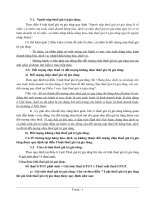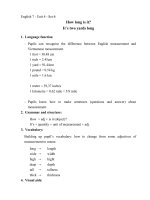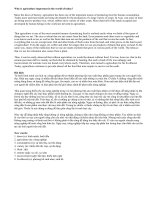Bài giảng why is biodiversity important
Bạn đang xem bản rút gọn của tài liệu. Xem và tải ngay bản đầy đủ của tài liệu tại đây (2.75 MB, 35 trang )
Why is Biodiversity Important?
Values are Subjective:
Perspectives and Scales
Local
communities
Land developer
Government
agency
Oil company
Aquaculture
company
Source: Sterling/Frey © AMNH-CBC
Environment
al group
The Value of Biodiversity
• Intrinsic/inherent
value
• Extrinsic/utilitarian/
instrumental
value
Source: Burmbaugh © AMNH-CBC
Intrinsic/inherent value
• The value of
something
independent of
its value to
anyone or
anything else
• A philosophical
concept
Source: Frey © AMNH-CBC
Intrinsic/inherent value
Example: Tuatara from New Zealand
Source: Wikimedia
Categorizing Values
Direct Use
Value(Goods)
Indirect Use
Value
(Services)
Non-Use Values
Food, medicine,
building
material, fiber,
fuel
Atmospheric and Potential (or
climate
Option) Value
regulation,
pollination,
nutrient
recycling
Future value
either as a good
or service
Cultural,
Spiritual and
Aesthetic
Existence Value
Value of knowing
something exists
Bequest Value
Value of knowing
that something
will be there for
future
generations
Direct Use Value: Goods
•
•
•
•
•
Food
Building Materials
Fuel
Paper Products
Fiber (clothing,
textiles)
• Industrial products
(waxes, rubber,
oils)
• Medicine
Source: © AMNH-CBC
Food
• Today, most people rely
on ~20 types of plants,
and only 3 to 4 are
staple crops.
• Diversity is critical for
developing new strains
and breeds, i.e. that suit
a particular
environment or are
resistant to pests or
disease and as a source
of new crops
Source: © AMNH-CBC
Building Materials, Paper Products, and Fuel
• In Vietnam, 50% of
building materials for
housing in rural areas rely
on bamboo in 2002.
Source: © AMNH-CBC
• The worldwide
production of timber and
related products –
including homes,
furniture, mulch,
chipboard, paper and
packaging – is a multibillion dollar industry.
Fiber
Source: USDA Cotton Program
While synthetic fibers, such as
polyester, that are manufactured
from petroleum products are
becoming increasingly common,
cotton (Gossypium sp.) is still the
single most important textile fiber in
the world, and accounts for over
40 percent of total world fiber
production in 2003.
Fibers extracted from plants and
animals are used to produce
textiles and cloth.
Source: USDA Photo b Ken Hammond
Paper Products in Vietnam
• According to the
National Forestry
Development Strategy,
Vietnam’s annual paper
and pulp production
reached 2.2 million tons
in 2011.
• Bai Bang Paper
Company, one of the
most famous Vietnam
factories, produces
about 90 thousand tons
of paper annually.
Source: baophutho.vn
Industrial Products
Originating plant or animal
Cork oak (Quercus suber)
Pará rubber tree (Hevea brasiliensis)
Lac insect (Laccifer spp.)
Carnauba palm (Copernicia
cerifera)
Wax plant (Euphorbia
antisyphilitica)
Jojoba plant (Simmondsia chinensis)
Cochineal insect (Dactylopius
coccus)
Product/End use
Cork
Rubber
shellac
carnauba wax
candelilla wax
jojoba oil
carmine dye*
Rubber production among
top seven countries
Source: the Association of Natural Rubber-Producing Countries, 2010
Medicine
• About 80% of the
people in
developing
countries use
plants as a primary
source of
medicine.
Source: © AMNH-CBC
• 57% of the 150
most-prescribed
drugs have their
origins in
biodiversity
Pharmaceuticals and Other Molecules
Drug
Purpose
Source
Amoxicillin Antibiotic
Fungus
Captopril
Antihypertensive
Animal
Digitoxin
Cardiotonic
Plant
Morphine
Analgesic
Plant
Penicillin
Antibiotic
Fungus
Quinine
Antimalarial,
antipyretic
Plant
Salicin
Analgesic
Plant
Vinblastine Antitumor
Plant
Codeine
Analgesic
Plant
Artemisin
Antimalarial
Plant
Traditional Medicine: Basis of Many Drugs
Drug
Source
Use
Barbaloin, aloe-emodin
Aloe (Aloe spp.)
Atropine
Belladonna (Atopa
belladonna)
Opium poppy (Papaver
somniferum)
Autumn crocus
(Colchicum autumnale)
Common foxglove
(Digitalis purpurea)
Joint fir (Ephedra sinica)
antibacterial, skin
cond itions, purgative
Relaxan t, sedative
Codeine
Colchicine
Digitoxin
Ephedrine,
Pseudoephedrine
L-Dopa
Menthol
M orphine
Quinine
Reserpine
Scopolamine
Taxol
Vinblastine, vin cristine
Velvet bean (Mucuna
deeringiana)
Mint (Menta spcs.)
Opium poppy (Papaver
somniferum)
Yellow cinchona
(Cinchona ledgeriana)
Indian snakeroot
(Rauvolfia serpentina)
Thornappl e (Datura metel)
Pacific Yew (Taxus
brevifolia)
Rosy periwinkle
(Catharanthus roseus)
Painkiller
Anticanc er agen t
Cardiac stimulant
Asthma, emphysema,
bronch iodilator, hay fever
Parkinson’s disease
Nasal conges tion
Painkiller
Malaria
Hypertension
Sedative
Anticanc er
Leukemia
Medicinal plants used in Vietnam
Protected
Areas
Ethnic groups
Population
Area (km2)
No of Medicinal
Plants
Ben En
Kinh, Muong,
Thai, Tay,
Tho
18,000
15,800
230
Tran & Ziegler
2001
Banh Ma
Kinh, Ta ku,
Van kieu,
H Mong
65,000
22,031
432
On 2003
Ba Vi
Dao
46,547
6,768
503
Pu Mat
Kinh, Thai, Kho
Mu, Dan
Lai, Poong,
H Mong, O
Du, Tay
93,333
91,113
610
85,000.000
330,000.000
3200
Study
Sam et al.,
2008
Thin & Nhan
2003
Chi 1996
All
54 ethnic
groups
Source: Hoang Van Sam et al., 2008
Value of Vietnam’s non-timber
forest product exports in 1996
Source: Ha Chu Chu, 1996
Indirect Use Values: Services
• Regulating global processes,
such as atmosphere and
climate
• Soil and water conservation
• Nutrient cycling
• Pollination and seed dispersal
• Control of agricultural pests
• Genetic library
• Inspiration and information
• Scientific and educational
• Tourism and recreation
• Cultural, spiritual, and
aesthetic
• Community Resilience
• Strategic
Source: © AMNH-CBC
Global Processes:
Atmospheric Regulation
• Photosynthetic
biodiversity created
an oxygenated
atmosphere, and also
has the potential to
moderate the rising
amounts of
atmospheric carbon
dioxide linked to
global climate
change
Source: Frey © AMNH-CBC
Global Processes: Climate
Regulation
• Forests and other vegetation modify climate: by affecting
sun reflectance, water vapor release, wind patterns and
moisture loss. Forests help maintain a humid environment,
for example, half of all rainfall in Amazon basin is
produced locally from forest-atmosphere cycle
Source: Bain © AMNH-CBC
Soil and Water Conservation
Example: Coastal wetlands and mangroves
•Filters excess nutrients
and traps sediments that
would otherwise impact
neighboring marine and
aquatic areas
Other services:
•Minimizes damage from
waves and floods
•Serves as a nursery for
juvenile commercial fish
•Provides habitat for many
birds, fish, and shellfish
Source: Ersts © AMNH-CBC
Nutrient Cycling
• Biodiversity is
critical to
nutrient
cycling and
soil renewal
• Decomposers
such as algae,
fungi, and
bacteria
Source: Snyder © AMNH-CBC
Pollination and Seed
Dispersal
• Many flowering plants
depend on animals for
pollination to produce
food.
• 30% of human crops
depend on free services
of pollinators;
replacement value
estimated at least 57
billions of dollars/year in
2006 in US alone.
Source: Spector© AMNH-CBC
Economic value of ecosystem services
Source: Costanza et a., 1997
Costanza et al., 1997
estimated that the
economic value of
17 ecosystem
services for 16
biomes to be in
the range of $16-54
trillion with an
average of $33
trillion. (Global gross
national product
valued at $18 trillion
per year)









